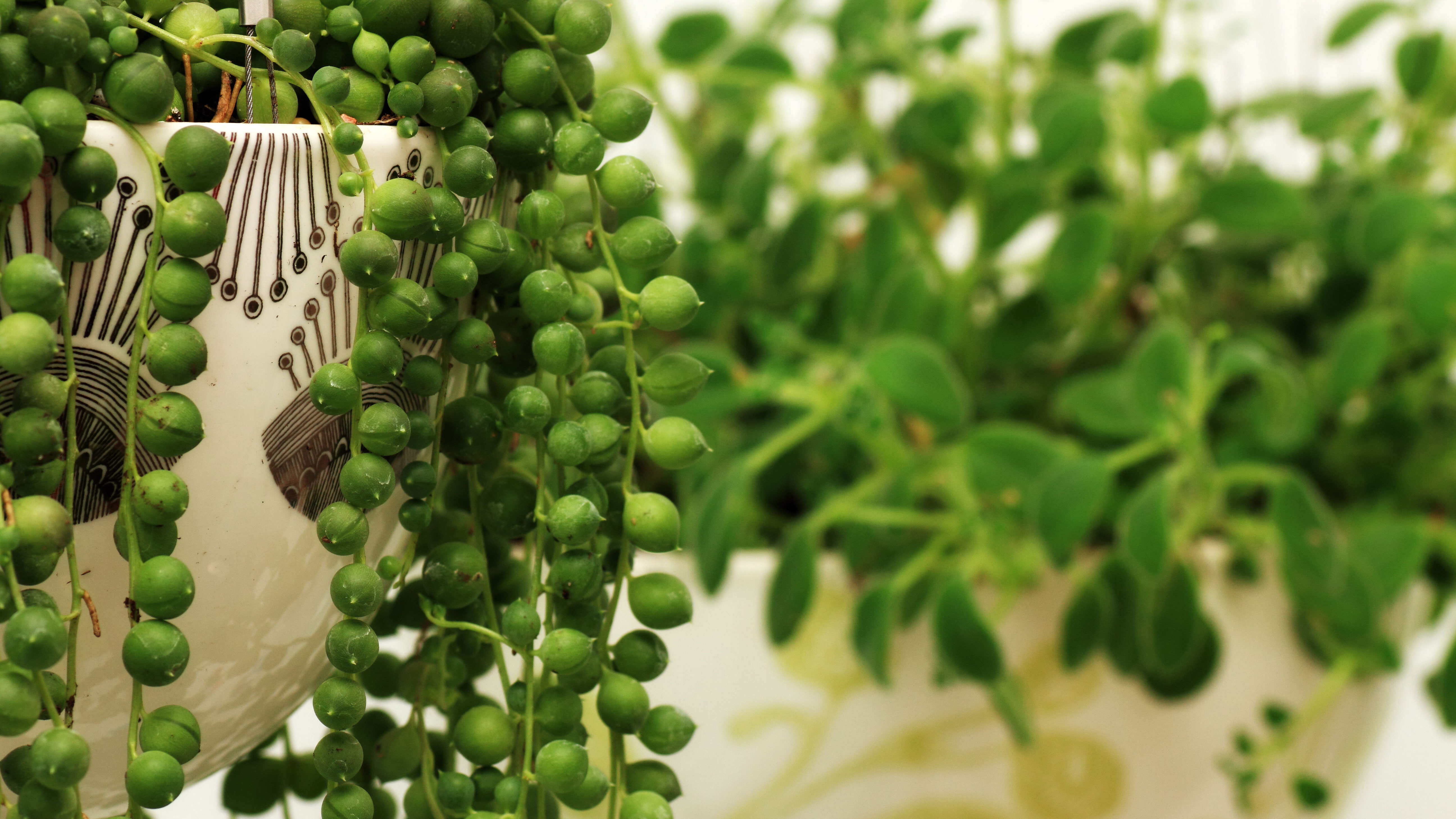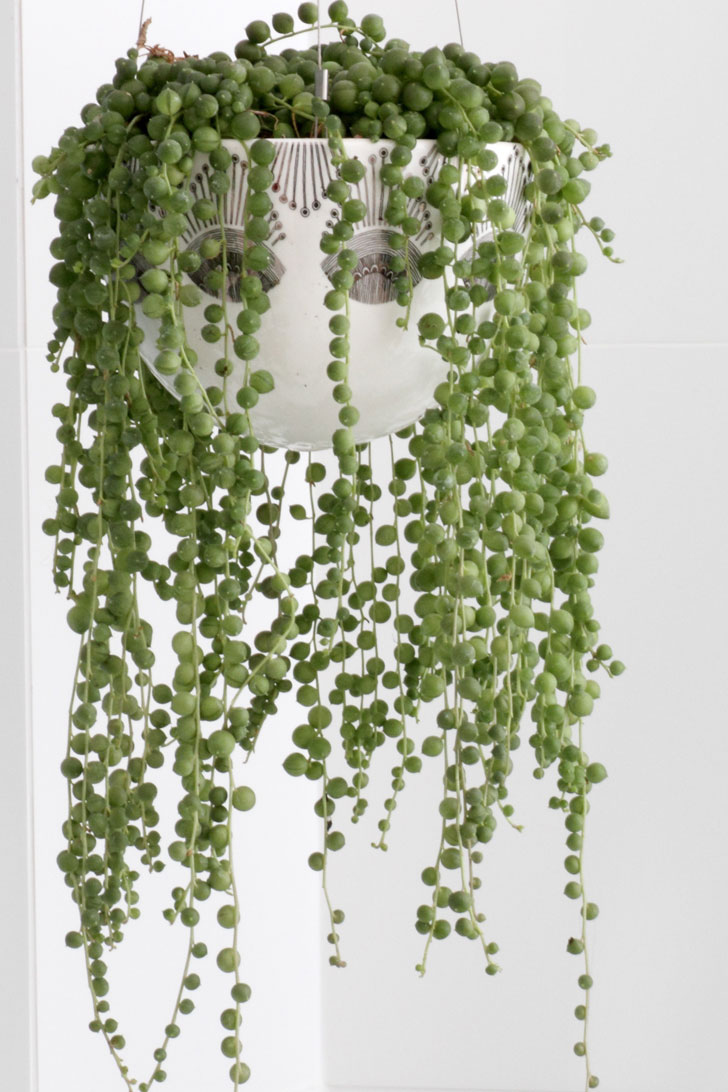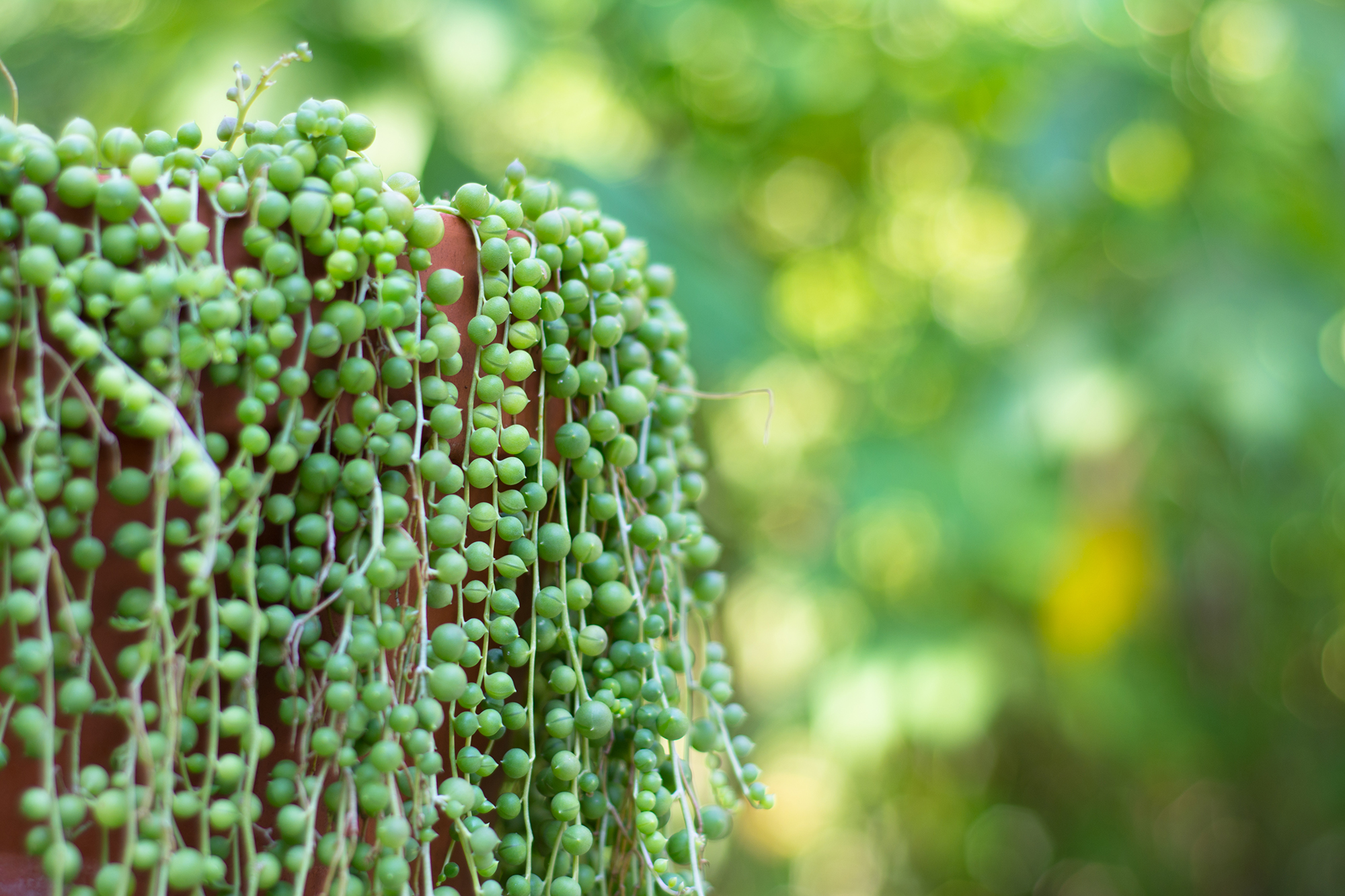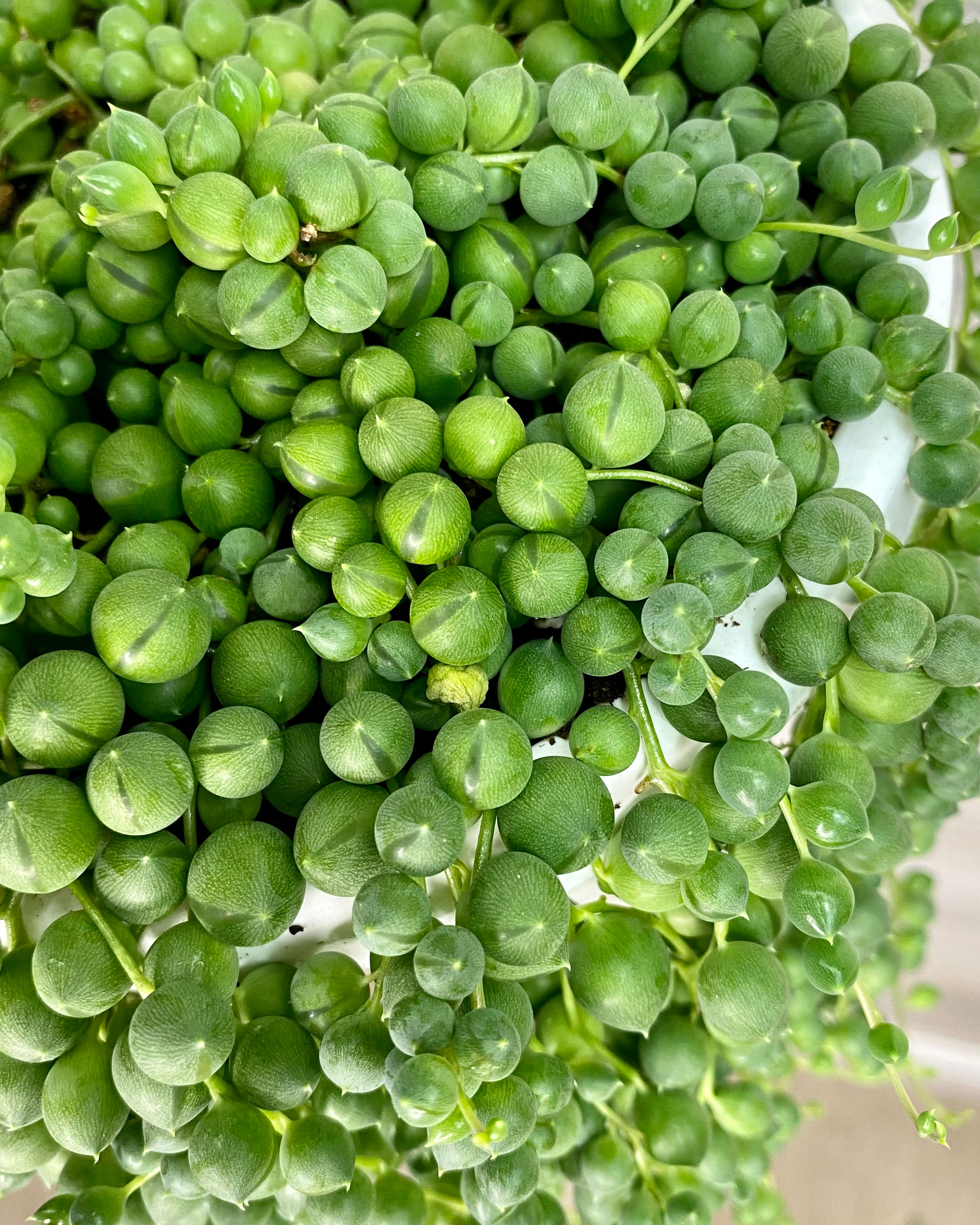How to care for a string of pearls plant – tips for success
Expert string of pearls plant care advice to ensure you get the best out of this popular house plant


Learn how to care for a string of pearls plant and you'll be rewarded with healthy and attractive trailing stems with small spherical leaves, which as the name suggests, look like the beads on a string of pearls. Look after them well and the tendrils can grow up to a meter in length. This popular plant is also known as the pea plant and its Latin name is Senecio rowleyanus.
That's the formal plant introductions dealt with – what you need to know next is that this easy-going, easy growing succulent is one of the best winter houseplants.
'String of pearls are one of our long-reigning favorites. Their incredible adaptations and unusual appearance means they’ll always have a place on our shelves,' says Alice Bailey, co-founder of Forest, which designed a house plant show garden at last year's RHS Chelsea Flower Show.
And as you'll discover, a place on our shelves – or in a hanging plant holder – is exactly where this plant can shine indoors, provided it's a bright spot.
It's a versatile plant, too. Tend a string of pearls plant carefully, and you can also grow it in the garden. In fact, it is one of the best plants for hanging baskets outside, its vivid green making a good contrast with more colorful flowering plants.
How to care for a string of pearls plant

Caring for a string of pearls plant is easy. 'As long as they’ve got plenty of light and aren’t being overwatered, they’re guaranteed to do well as a houseplant!' says Alice Bailey.
Shannon Bernadin, botanist and CEO of The African Garden, says: 'String of pearls plants will grow really well if they are provided with at least 6 to 8 hours a day of bright and indirect sunlight. They enjoy temperatures around 72ºF, and they can be grown either indoors or outdoors and don’t need much humidity in order to thrive.'
Design expertise in your inbox – from inspiring decorating ideas and beautiful celebrity homes to practical gardening advice and shopping round-ups.
There's good news for inexperienced or hands-off house plant gardeners from Dan Bruce, owner of Leafy: 'The string of pearls is from the succulent family and therefore, requires minimal water. In fact, it thrives on neglect!' he says. 'They are super decorative and make great features in pots with designs that feature ‘faces.’
Be warned, though: handle string of pearls plants with care. The plant is mildly toxic and the delicate bead leaves drop from the stems quite easily if they are moved around, so keep them away from children and pets.
What conditions does a string of pearls plant need?

Understand the plant's origins and its growing habits in the wild, and you'll understand how to care for a string of pearls plant.
Forest's Alice Bailey explains: 'They’re naturally found spreading across the desert floors of Southern Africa where water is limited and light and heat levels are extremely high. In order to stop water escaping through their leaves, they’ve adapted to become thick, fleshy and pearl-like.'
In summary, the best conditions for a string of pearls plant to thrive are:
Free draining compost – cactus and succulent compost is perfect;
Use a succulent feed through spring and summer to encourage growth;
Plenty of direct light and warmth – although they can tolerate temperatures down to 50ºF (10ºC).
On the subject of temperature, if you're growing a string of pearls plant as a house plant, Dan Bruce says: 'Keep them out of conservatories as the string of pearls will not favor low temperatures. Keep them well away from any environment that may experience humidity (even in short bursts) such as a bathroom or kitchen. Any room with a south-facing window is perfect.'
Does a string of pearls plant ever flower?

If the conditions and care are right, and winter temperatures don't dip below 55-61ºF (13-16ºC), a string of pearls plant may produce small white flowers with an unusual cinnamon scent. The flowers appear in spring, however, most growers prize the plant's delicate tendrils of leaves more highly than its fairly insignificant blooms.
Does a string of pearls plant need direct sunlight?
String of pearls plants need regular sunlight every day and so if they are positioned in a dark corner they will not thrive.
The expert advice on how to care for a string of pearls plant is that eight hours of indirect sunlight will provide a better growing environment than full-on direct sunlight.
However, it's a delicate balance for this delicate-looking plant. 'The nature of the string of pearls' thick, round leaves makes photosynthesis much more difficult, explains Alice Bailey. 'It can only be achieved through a thin, pale slit (known as an epidermal window) on the beads. Because of this, string of pearls need to be exposed to at least a few hours of direct sunlight (hitting both the top and sides of the plant) when in the home, so hanging in a south-facing window is ideal.'
Is there such a thing as too much sunlight for these plants? Lindsey Hyland says: ' If the string of pearls plant in your home begins to turn yellow, it could be a sign that it's receiving too much light. Try moving your potted plant to a location with slightly less intense sunlight.'
How often do string of pearls need water?
String of pearls plants naturally grow in dry conditions so don't need to be watered more than once a fortnight and you should be very careful not to over-water them. It's a good idea to water pot-grown string of pearls plants from below, allowing them to soak water up from the base of the pot so the delicate pearl foliage isn't sitting directly on wet compost.
For specimens grown indoors as house plants, a sparing approach to watering is required. 'A string of pearls does not need a lot of water, so make sure to water them only when they are fully dry.' says Eli Manekin, founder of Loop Living. 'You can check by inserting your finger into the soil and making sure it's not damp and has a sand-like consistency.'
Alice Bailey agrees, adding: 'They’re used to extended periods of drought so water only when the soil has completely dried all the way down to the base of the pot, or when the leaves are just starting to shrivel.'
Lindsey Hyland, founder of UrbanOrganic Yield adds: 'Avoid getting the plant's leaves wet when watering, as this can lead to leaf spot disease. Remove any dead or wilted leaves from the stem as needed to keep the plant looking its best.'
Growing a string of pearls plant outside

String of pearls plants grow well outside in sunny spots with plenty of direct light. Their textural leaves and unusual trailing, spreading habit make them a good and interesting choice for hanging baskets.
Mimic the sandy, dry well-drained conditions of their natural Southern African desert habitat and they should do well outside. 'If it's really hot and dry outside then you may need to water them more often,' advises Lindsey Hyland.
Repotting a string of pearls plant

String of pearls plants don’t need to be repotted often as they have quite a shallow root base.
There are two clear signs to look out for that indicate your string of pearls is ready to upscale, says Lindsey Hyland. 'If the plant becomes root-bound, its roots will grow in a circular pattern and may start to grow out of the pot. The plant will also start to slow down its growth rate and may lose leaves.'
When you do repot your plant, use a free draining cactus and succulent compost and select your pot carefully – a terracotta or ceramic pot is better for drainage and is less likely to become waterlogged. 'It’s important to pot them into something low and wide in order to 'let them mimic the way they would grow in their natural habitat ,' says Alice Bailey, 'spreading rather than trailing – as this will allow for a fuller root base and in turn, a fuller and longer trailing plant.'
Karen Musgrave of Hicks Nurseries advises repotting a spring of pearls plant in spring, but only if needed. 'They tend to thrive in small pots and should only be repotted once the roots can be seen through the drainage holes in the bottom of the container. Choose a pot that is no more than 2 inches larger than its current pot and has good drainage.'
Water thoroughly after repotting.
When to prune a string of pearls plant
A string of pearls plant requires very little pruning, however, as with all plants it's always good to keep an eye on its condition and prune very minimally very occasionally if necessary. 'Remove any dead or wilted leaves from the stem as needed to keep the plant looking its best,' advises Lindsey Hyland.
'To make your plants fuller, consider propagation,' says Karen Musgrave. 'Take about a 4-inch long cutting and place it in water. After about 3-4 weeks roots will form and you’ll have another plant to add back into your existing pot or to start a new planter.'
Karen sources beautiful homes to feature on the Homes & Gardens website. She loves visiting historic houses in particular and working with photographers to capture all shapes and sizes of properties. Karen began her career as a sub-editor at Hi-Fi News and Record Review magazine. Her move to women’s magazines came soon after, in the shape of Living magazine, which covered cookery, fashion, beauty, homes and gardening. From Living Karen moved to Ideal Home magazine, where as deputy chief sub, then chief sub, she started to really take an interest in properties, architecture, interior design and gardening.
